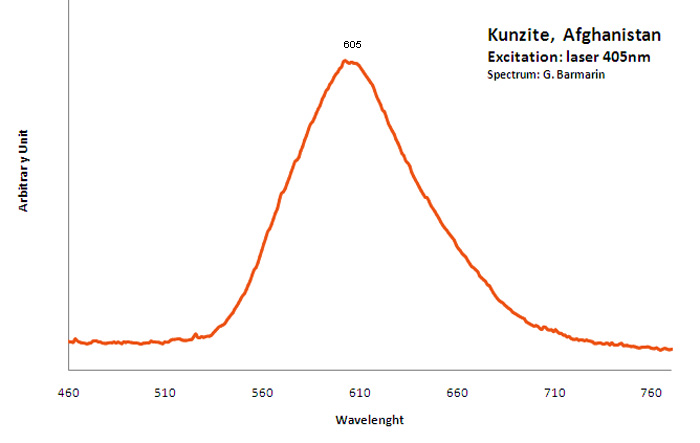Base de données des minéraux luminescents
kunzite
Formule chimique: Voir SPODUMENE
Famille: Silicates
Statut: NON APPR
Système cristallin : Monoclinique
Minéral de vitrine: OUI
Luminescence:
Couleurs UV longs (365nm): |
Orange , | ||
Couleurs UV courts (254nm): |
Rose saumon (rose orange) , Rose violacé , | ||
Photo en lumière du jour

Kunzite;
Darre Pech, Nangarhar Province, Afghanistan
Photo and Copyright:
Middleearthminerals.com
Used with permission of the author
Photo Ondes Courtes (254nm)

Kunzite;
Darre Pech, Nangarhar Province, Afghanistan
UVSW, Photo and Copyright:
Middleearthminerals.com
Used with permission of the author
Vous avez une photo de ce minéral que vous voudriez voir figurer dans la galerie? Contactez-nous!
Phosphorescence (au sens commun du terme) observable à l'oeil nu:
Type d'UV |
Couleur |
Intensité |
Fréquence d'observation |
|---|---|---|---|
UV longs (365nm): | Orange | Moyenne | UV courts (254 nm): | Rouge violacé | Moyenne |
Thermoluminescence: OUI
Activateur(s) et spectre(s):
Activateur(s): Mn2+ , Cr3+, TiO6,
Pics dans le spectre (nm):
Large band at 430 nm, Mn2+ : large band peaking around 620 nm (Gorobets) large band peaking at 605nm

Col. G. Barmarin; Spectre: G. Barmarin
Commentaires sur les spectres et les activateurs (*):
The phosphorescence of Kunzite was discovered by G. F. Kunz himself in 1903. Baskerville also studyed Kunzite luminescence in 1903. Extended studies were later made on the spectra of Kunzite by Pochettino and by Nichols who found that the fluorescence emitted light was polarized. Nichols also describe the fluorescence emitted by electron excitation as two bands : a strong broad band from 515nm to 690nm and a weak one extending from 420nm to 480nm. He also pointed that the band around 600nm have a strong phosphorescence and the other band have none. Nichols studied the thermoluminescence at 325°C and found that it was not polarized. The thermoluminescence ceased at 400°C. At 20°C the peak around 590nm is nearly symetric being somewhat steeper toward the violet. On cooling to -180°C, the fluorescence color becomes much redder to the eye but the spectrum show no resolution into narrow bands (DeMent 1949) Tanaka (1921-1932) demonstrated that the most important activating agents wich cause the luminescence of Kunzite is Manganese. However, he stated that Samarium and Ytterbium had a role as activator. In the Kunzite from Pala, Ca, USA, containing a few tenths of a percent of manganese, he found in the bright orange light emitted by fluorescence 12 manganese bands, 4 samarium bands and one thallium band.
(*)Les commentaires sur les spectres sont uniquement rédigés en Anglais
Meilleure(s) localité(s) pour la fluorescence (*):
- Nuristan Province, Afghanistan;
- Laghman Province, Afghanistan;
- Dara-i-Pech pegmatite field, Chapa Dara District, Konar Province, Afghanistan;
- Gilgit, Gilgit District, Gilgit-Baltistan, Pakistan;
- Mt Apatite, Maine, USA (phosphorescent);
- Newry, Maine, USA (phosphorescent);
(*)Les données ne sont pas exhaustives et sont limitées à quelques localités remarquables pour la fluorescence
Référence bibliographique pour la luminescence:
- The Henkel Glossary of Fluorescent Minerals, Dr. Gerhard Henkel, Published by the FMS, 1989 ,
- Fluorescence: Gems and Minerals Under Ultraviolet Light, Manuel Robbins, 1994, Geoscience Press, ISBN 0-945005-13-X ,
- The World of Fluorescent Minerals, Stuart Schneider, Schiffer Publishing, 2006, ISBN 0-7643-2544-2 ,
- Luminescent Spectra of Minerals, Boris S. Gorobets and Alexandre A. Rogojine, Moscow, 2002 ,
- Handbook of Fluorescent Gems and Minerals, a practical guide for the gem and mineral collector, Jack de Ment, 1949 ,
Référence pour la luminescence sur internet:
Images
Référence minéralogique sur internet:
 http://www.mindat.org/show.php?name=Kunzite
http://www.mindat.org/show.php?name=Kunzite
 http://webmineral.com/data/Kunzite.shtml
http://webmineral.com/data/Kunzite.shtml
Recherche sur Internet:
 Recherche d'images sur 'Google Image'
Recherche d'images sur 'Google Image'
 Recherche de documents en français sur Google
Recherche de documents en français sur Google
 Recherche de documents en toutes
langues sur Google
Recherche de documents en toutes
langues sur Google
Une requête ne donnant pas de résultat signifie uniquement qu'aucune référence de ce type n'existe dans la base mais en aucun cas qu'elle n'existe pas dans l'absolu. Si vous considérez avoir trouvé une erreur ou une omission, merci de nous le signaler via la page contact en n'oubliant pas de citer la source de l'information.
